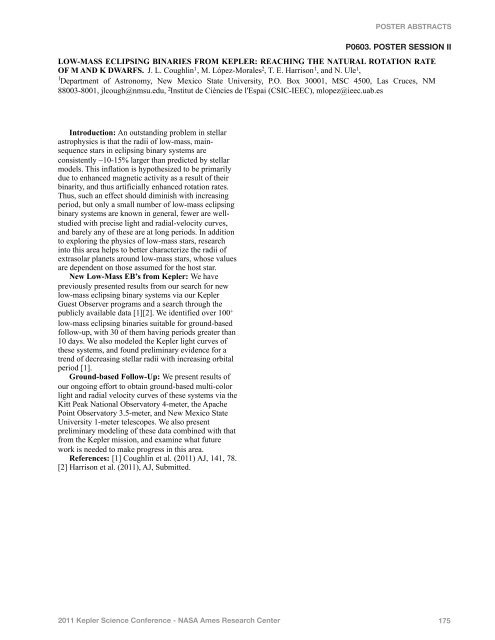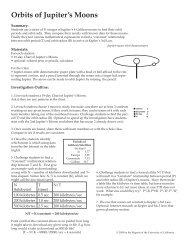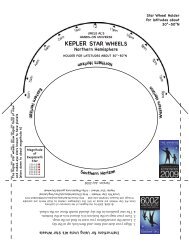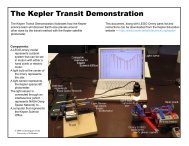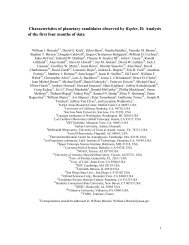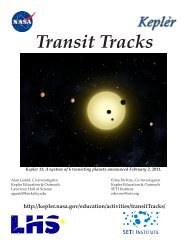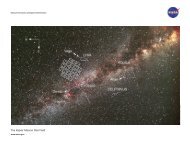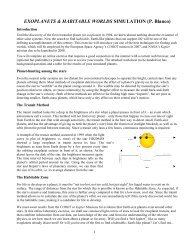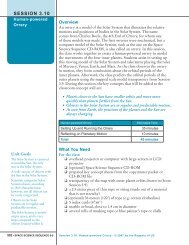Poster Abstracts - Kepler - NASA
Poster Abstracts - Kepler - NASA
Poster Abstracts - Kepler - NASA
- No tags were found...
You also want an ePaper? Increase the reach of your titles
YUMPU automatically turns print PDFs into web optimized ePapers that Google loves.
POSTER ABSTRACTSP0603. POSTER SESSION IILOW-MASS ECLIPSING BINARIES FROM KEPLER: REACHING THE NATURAL ROTATION RATEOF M AND K DWARFS. J. L. Coughlin 1 , M. López-Morales 2 , T. E. Harrison 1 , and N. Ule 1 ,1 Department of Astronomy, New Mexico State University, P.O. Box 30001, MSC 4500, Las Cruces, NM88003-8001, jlcough@nmsu.edu, 2 Institut de Ciències de l'Espai (CSIC-IEEC), mlopez@ieec.uab.esIntroduction: An outstanding problem in stellarastrophysics is that the radii of low-mass, mainsequencestars in eclipsing binary systems areconsistently ~10-15% larger than predicted by stellarmodels. This inflation is hypothesized to be primarilydue to enhanced magnetic activity as a result of theirbinarity, and thus artificially enhanced rotation rates.Thus, such an effect should diminish with increasingperiod, but only a small number of low-mass eclipsingbinary systems are known in general, fewer are wellstudiedwith precise light and radial-velocity curves,and barely any of these are at long periods. In additionto exploring the physics of low-mass stars, researchinto this area helps to better characterize the radii ofextrasolar planets around low-mass stars, whose valuesare dependent on those assumed for the host star.New Low-Mass EB’s from <strong>Kepler</strong>: We havepreviously presented results from our search for newlow-mass eclipsing binary systems via our <strong>Kepler</strong>Guest Observer programs and a search through thepublicly available data [1][2]. We identified over 100 +low-mass eclipsing binaries suitable for ground-basedfollow-up, with 30 of them having periods greater than10 days. We also modeled the <strong>Kepler</strong> light curves ofthese systems, and found preliminary evidence for atrend of decreasing stellar radii with increasing orbitalperiod [1].Ground-based Follow-Up: We present results ofour ongoing effort to obtain ground-based multi-colorlight and radial velocity curves of these systems via theKitt Peak National Observatory 4-meter, the ApachePoint Observatory 3.5-meter, and New Mexico StateUniversity 1-meter telescopes. We also presentpreliminary modeling of these data combined with thatfrom the <strong>Kepler</strong> mission, and examine what futurework is needed to make progress in this area.References: [1] Coughlin et al. (2011) AJ, 141, 78.[2] Harrison et al. (2011), AJ, Submitted.2011 <strong>Kepler</strong> Science Conference - <strong>NASA</strong> Ames Research Center 175


